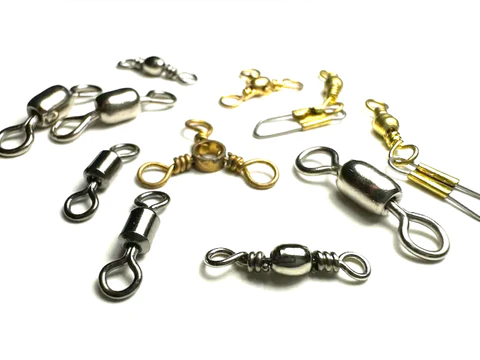Fishing swivels, those small but crucial components of any fishing rig, come in an array of sizes and types, ready to elevate your fishing game. Here’s a breakdown of everything you need to know about swivels for your next fishing adventure.
Understanding Fishing Swivels
A fishing swivel is a vital piece of terminal tackle, featuring a pivoting joint in the middle and two metal rings at the ends. This design allows the rings to rotate freely, preventing line twists common with rotating lures or rigs.
Why Use Fishing Swivels?
Line twists can be a nuisance for anglers, causing knots, tangles, and even line breakage. Fishing swivels act as a solution, enabling lures or rigs to rotate freely without impacting the fishing line.

Tying a Swivel onto Your Fishing Line
Mastering the art of tying a swivel onto your fishing line is essential. Follow these steps:
- Pass the fishing line through the swivel eye.
- Create a loop by doubling the line parallel to the vertical line.
- Wrap the end of the loop around the main line at least five times.
- Pass the loop’s end through the small opening between the swivel’s eye and the wraps.
- Moisturize the line and pull the standing line to tighten the knot.
- Trim any excess line and test the knot’s strength.
Where to Buy Fishing Swivels?
Several options cater to your fishing swivel needs. Consider reputable online platforms like Hunting and Fishing Depot, or visit local sporting goods stores such as Dick’s Sporting Goods. Specialist tackle stores and online marketplaces like Amazon and eBay are also viable options. Compare prices, read reviews, and factor in shipping costs to secure the best deal.
Choosing Swivel Sizes for Specific Fishing Styles
For bass fishing, opt for sizes 2 to 4 for a balanced mix of strength and maneuverability. If targeting larger bass or using heavier tackle, sizes 4 to 6 are suitable. In surf fishing, sizes 1 to 3/0 are recommended, with size 1 for smaller species and 3/0 for larger fish like bluefish or redfish.

Fishing Swivel Size Chart
Utilize a fishing swivel size chart to match swivel sizes with line poundage. These charts offer a quick reference, ensuring a secure connection between the swivel and the fishing line.
Types of Fishing Swivels and Their Applications
- Barrel Swivel: Basic and versatile, suitable for light to medium fishing applications.
- Rolling Swivel: Ideal for heavy loads, excelling under pressure, and preventing line twists in live bait or strong currents.
- Ball Bearing Swivel: Advanced with a ball bearing mechanism for smoother rotation and less friction, suitable for heavy-duty fishing.
Why Every Angler Should Use Barrel and Crane Swivels
- Barrel Swivels: Prevents line twists and tangles, easy to use, affordable, and widely available.
- Crane Swivels: Offers a streamlined design, easy attachment with a snap, and prevents line twisting in strong currents.
Choosing the right fishing swivel involves considering the type of fishing, line strength, and specific requirements. Armed with this knowledge, you’ll enhance your fishing experience, minimize line issues, and increase your chances of a successful catch.
Images/Source: HFDepot





